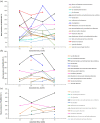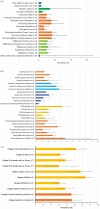Long-COVID-19 clinical and health outcomes: an umbrella review
- PMID: 37720384
- PMCID: PMC10501084
- DOI: 10.1177/20499361231198335
Long-COVID-19 clinical and health outcomes: an umbrella review
Abstract
Background: A growing interest in long-term sequelae of COVID-19 has prompted several systematic literature reviews (SLRs) to evaluate long-COVID-19 effects. However, many of these reviews lack in-depth information on the timing, duration, and severity of these conditions.
Objectives: Our aim was to synthesize both qualitative and quantitative evidence on prevalence and outcomes of long-term effect of COVID-19 through an umbrella review.
Design: Umbrella review of relevant SLRs on long-COVID-19 in terms of prolonged symptoms and clinical conditions, and comprehensively synthesized the latest existing evidence.
Data sources and methods: We systematically identified and appraised prior systematic reviews/meta-analyses using MEDLINE, Embase, and Cochrane database of systematic review from 2020 to 2021 following the preferred reporting items for systematic reviews and meta-analyses guidance. We summarized and categorized all relevant clinical symptoms and outcomes in adults with COVID-19 using the Medical Dictionary for Regulatory Activities System Organ Class (MedDRA SOC).
Results: We identified 967 systematic reviews/meta-analyses; 36 were retained for final data extraction. The most prevalent SOC were social circumstances (40%), blood and lymphatic system disorders (39%), and metabolism and nutrition disorder (38%). The most frequently reported SOC outcomes within each MedDRA category were poor quality of life (59%), wheezing and dyspnea (19-49%), fatigue (30-64%), chest pain (16%), decreased or loss of appetite (14-17%), abdominal discomfort or digestive disorder (12-18%), arthralgia with or without myalgia (16-24%), paresthesia (27%) and hair loss (14-25%), and hearing loss or tinnitus (15%).
Conclusion: This study confirmed a high prevalence of several long COVID-19 outcomes according to the MedDRA categories and indicated that the majority of evidence was rated as moderate to low.
Registration: The review was registered at PROSPERO (https://www.crd.york.ac.uk/prospero/) (CRD42022303557).
Keywords: MedDRA system organ classes; clinical outcomes; long COVID-19; prevalence; umbrella review.
© The Author(s), 2023.
Conflict of interest statement
The authors declared the following potential conflicts of interest with respect to the research, authorship, and/or publication of this article: DB and JX are employees of Takeda. FI is an employee of CSL Behring LLC. MSG is an employee of Bayer AG. MG is a full-time employee of Merck. HL and RAB are employees of Gilead Sciences Inc. ABTT was funded by the Grant CENTRO-04-3559-FSE-000162 within the European Social Fund (ESF). All other authors report no conflict of interest.
Figures




Similar articles
-
Chest Computed Tomography for the Diagnosis of COVID-19 in Emergency Trauma Surgery Patients Who Require Urgent Care During the Pandemic: Protocol for an Umbrella Review.JMIR Res Protoc. 2021 May 6;10(5):e25207. doi: 10.2196/25207. JMIR Res Protoc. 2021. PMID: 33878019 Free PMC article.
-
Beyond the black stump: rapid reviews of health research issues affecting regional, rural and remote Australia.Med J Aust. 2020 Dec;213 Suppl 11:S3-S32.e1. doi: 10.5694/mja2.50881. Med J Aust. 2020. PMID: 33314144
-
The future of Cochrane Neonatal.Early Hum Dev. 2020 Nov;150:105191. doi: 10.1016/j.earlhumdev.2020.105191. Epub 2020 Sep 12. Early Hum Dev. 2020. PMID: 33036834
-
Effectiveness and safety of manual therapy for knee osteoarthritis: An overview of systematic reviews and meta-analyses.Front Public Health. 2023 Feb 24;11:1081238. doi: 10.3389/fpubh.2023.1081238. eCollection 2023. Front Public Health. 2023. PMID: 36908468 Free PMC article.
-
Barriers and facilitators to patient uptake and utilisation of digital interventions for the self-management of low back pain: a systematic review of qualitative studies.BMJ Open. 2020 Dec 12;10(12):e038800. doi: 10.1136/bmjopen-2020-038800. BMJ Open. 2020. PMID: 33310794 Free PMC article.
Cited by
-
Clinical outcomes in newborns of pregnant women with COVID-19: integrative review.Rev Bras Enferm. 2024 Jun 28;77Suppl 1(Suppl 1):e20230400. doi: 10.1590/0034-7167-2023-0400. eCollection 2024. Rev Bras Enferm. 2024. PMID: 38958355 Free PMC article. Review.
-
Diaphragmatic strengthening exercises for patients with post COVID-19 condition after mild-to-moderate acute COVID-19 infection: a randomized controlled study.J Rehabil Med. 2024 Jun 11;56:jrm25491. doi: 10.2340/jrm.v56.25491. J Rehabil Med. 2024. PMID: 38860716 Free PMC article. Clinical Trial.
-
Kidney Disease and Proteomics: A Recent Overview of a Useful Tool for Improving Early Diagnosis.Adv Exp Med Biol. 2024;1443:173-186. doi: 10.1007/978-3-031-50624-6_9. Adv Exp Med Biol. 2024. PMID: 38409421
References
-
- World Health Organization. Health emergency dashboard, https://covid19.who.int/ (2021, accessed May 2022).
-
- Office for National Statistics. Prevalence of ongoing symptoms following coronavirus (COVID-19) infection in the UK, https://www.ons.gov.uk/peoplepopulationandcommunity/healthandsocialcare/... (2021, accessed January 2023).
Publication types
LinkOut - more resources
Full Text Sources

